Guides to materials – Material properties and comparison charts
Specific gravity
This chart displays specific gravity of materials, which is the density of a material relative to the density of water.
Compared to metals, ceramics tend to have less than half of the density. Furthermore, tungsten is heavier than lead and around the same weight as gold, making it an unusually dense material. Therefore, tungsten is often used as radiation shielding.
Comparative specific gravity graph
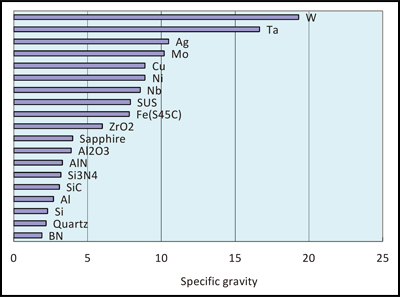
Hardnes
This graph displays the hardness of various materials measured by Vickers hardness.
Ceramics tend to be much harder than commonly used metals. It means that they have higher wear resistance and are widely used as abrasion resistant materials.
Comparative hardness graph
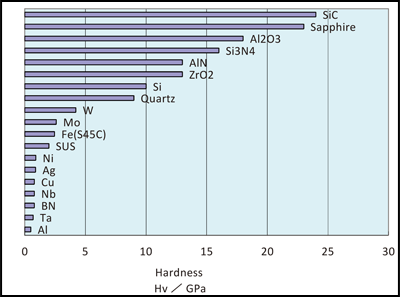
Young`s modulus
The higher the Young’s Modulus of a certain material is, the stiffer it is and the better it can withstand tension occuring.
Compared to other materials, ceramics, tungsten and molybdenum have a very high Young’s modulus.
Young`s modulus comparative graph
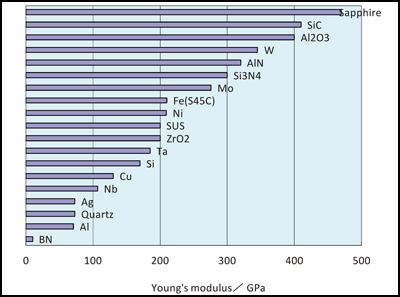
Fracture toughness
Fracture toughness can be defined as resistance to crack growth.
Generally, ceramics are extremely brittle. However, among them, zirconia has high fracture toughness, and is often used in kitchen knives, scissors and wrecking balls.
Comparative fracture toughness graph
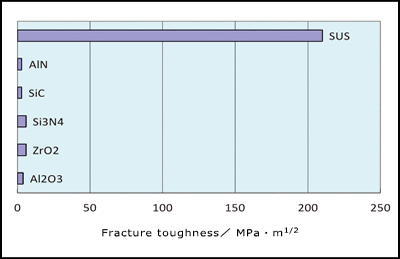
Max. use temp.
The maximum use temperature determines the temperature range in which a material is possible to use. It varies depending on atmosphere. Materials with high melting point such as tungsten, molybdenum and ceramics have various applications which require high heat resistance. For example, furnance materials, crucibles, and heat shielding.
Comparative graph of maximum use temperature
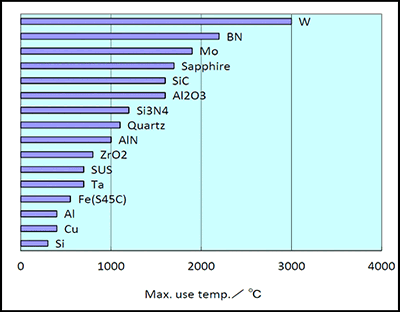
Thermal shock resistance
Temperature range in which a material can withstand rapid changes in temperature. The higher the thermal shock resistance is, the lower the risk the material breaks due to rapid temperature changes. Glass and ceramics are easy to break with abrupt temperature change. However, boron nitride, quartz, and silicon nitride have a very high thermal shock resistance. These materials are frequently used in parts that are required to withstand extreme temperature fluctuation.
Comparative thermal shock resistance graph
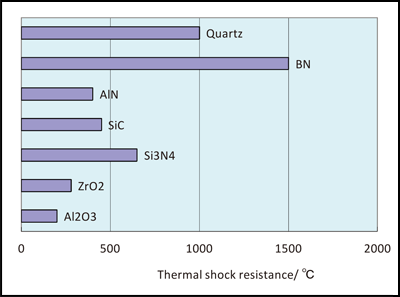
Thermal conductivity
This graph displays how well the heat is transfered through different materials.
Certain ceramics like aluminium nitride and silicon carbide have high thermal conductivity whereas others such as zirconia have very low conductivity. Tungsten and molybdenum conduct heat comparatively well.
Thermal conductivity comparison graph
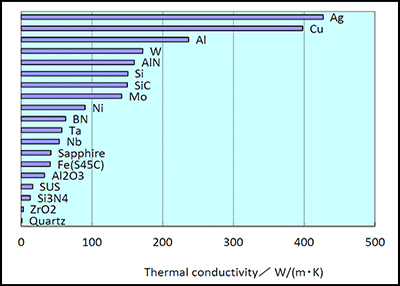
Coefficient of thermal expansion
Rate of material expansion in response to a change of temperature.
Since ceramics, tungsten and molybdenum have low thermal expansion coefficient, there is only a minor change in shape in response to temperature variation.
Comparative graph for thermal expansion coefficient
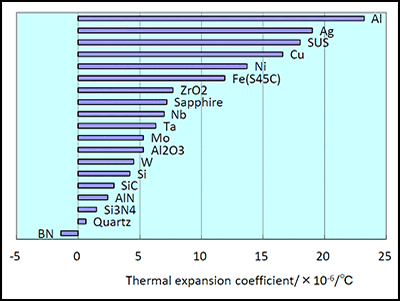
Electrical resistivity
Electrical resistivity, also known as volume resistivity, is the property which explains how difficult it is for electricity to pass through a material. Ceramics in general have high electrical resistivity. Therefore, they are commonly used as insulation materials. Some ceramics have electro conductive properties, such as SiC.
Electrical resistivity graph
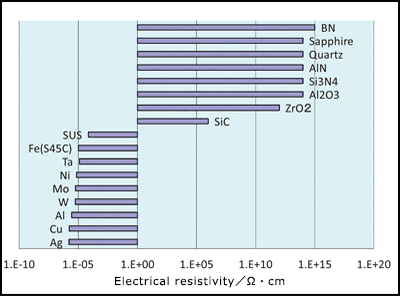
Relative permittivity
Permittivity describes how much dielectric polarization in a material occurs, if applying an electric field on it. The relative permittivity (also known as Dielectric constant), is the permittivity of a material in ratio to the permittivity of vacuum. The lower the relative permittivity is, the smaller the dielectric polarization is established in a material. Therefore the material gets hardly affected by surrounding electric fields. That is why its popular application is in semiconductor processing equipment.
Corrosion resistance
Corrosion resistance describes how well a material can withstand chemical or biological effects without degradation of its properties or structure. Since ceramics have high corrosion resistance, they can be used in prosthetic limbs and various other corrosion resistive parts. Tungsten resists acid and alkali in a similar manner as ceramics.
Electric conductivity
In general, advanced ceramics are insulation materials that do not conduct electricity. Depending on voltage or temperature, some of them can become semiconductors.
Piezoelectricity
After applying mechanical stress to materials, some of them generate electric charge. Conversely, inverse piezoelectric effect occurs, when an electric field is applied and deformation to a material is generated. Piezoelectric ceramics have polycrystalline structure. An example of piezoelectric material is lead zirconate titanate (PTZ in short).




